The Downtown Plan is about to take the next step, with draft recommendations due from City Planning staff on September 23rd. The draft recommendations are the framework from which the planning staff will write the draft of the plan, which will then go to the approval bodies for revision and adoption. Planning staff is going to take feedback on the draft recommendations in September and October, and then in November begin work on the plan proper. The city has been working on the plan since the spring of 2008, though the Edgewater struggle has slowed the plan by about six months.
Planning staff is still tweaking their draft recommendations, and one large item remaining is what to do about Mifflin – specifically, the 400 and 500 blocks of W Mifflin, or “Miffland”. Miffland is a special part of Madison, and elicits many strong feelings and ideas on what could or should happen there in the future. Planning staff received a lot of feedback, pushing in a wide range of directions, and Mifflin is one of the last pieces of the downtown plan puzzle to come together.
On Monday night, the planning staff brought some draft-draft recommendations forward, and showed them off at a small public meeting, and then immediately afterwards to the Plan Commission. The idea was to get a sanity check on the general direction they’re taking for the draft recommendations for the area.
The public meeting was first – Bill Frulhing from the Planning Department did most of the presenting. The latest issue of the downtown plan update was handed out, along with concepts handouts for the concepts he’s going to discuss. There were about 20 members of the public there, mostly (nearly all?) Mifflin West or Basset neighborhoods.
The audio from this meeting is here. It’s only what my iPhone recorded, but it’s decent quality.
Bill invited everyone to the big rollout of the plan is September 23rd, Promenade Hall @ Overture, as well as a followup on October 7th for the people who couldn’t make the 23rd.
The handouts from the meeting are all available on the city’s Downtown Plan website.
[Now, a bit more into live-blog mode]
Bill: The purpose of tonight’s meeting is to talk a little bit about the West Mifflin St area – 400 and 500 blocks of Mifflin and W Wash.
As we’ve been working through the plan over the last two+ years, we think the pieces have all fallen into place.
Showing off a map of the downtown “Character Area Maps” –neighborhoods or pieces that really hang together. The area that we’re really talking about tonight is the area called Mifflin, bounded by Dayton/Bedford/Wash/Broom.
This is an area that throughout the process, people have very strong opinions about this area. Some people that believe that basically it should stay like it is, or maybe improved, but keep the houses that are there as the future for the area. There are people who think that these are a bunch of houses that have been cut up into student apartments and are a bit run-down, and is that really the future of the area?
Looking at a 25-year planning horizon, not talking about changes tomorrow. Presenting options at the extreme, because we have such a diversity of input and diversity in viewpoints even among staff. In February, we went to Plan Commission, got sort of OKs for directions on most everything else. However, we really tried to engage them in a discussion about Mifflin, but even plan commission wasn’t sure what to do with Mifflin. We think what we took away from that was general feedback to preserve the “core” feel of the area but is enhanced, so it doesn’t just continue like it is for the next 25 years. Maybe buildings themselves stay the same, or at least building size says the same. However, could have opportunities to make some changes at the edges.
We took those “nuggets” away from the process, and tried to create some concepts that are a little more concrete/detail that the Plan Commission and public can respond to instead of earlier “conceptual” ideas.
Later tonight, we’re going to take this to Plan Commission, but because it’s part of a special meeting and there’s not much time, we’ve scheduled this public meeting more for the public, so we can hear from you and get your feedback while still giving the plan commission as much time as possible.
Now presenting a “Conceptual Pattern of Maximum Building Heights” map, Mifflin is marked as “3”. Coming out of February, had a lot of options for different concepts.
So, after the Plan Commission work sessions, we started trying to look at alternatives more in the middle. Really focused on keeping the core/essence of W Mifflin st, but also look at opportunities to incorporate additional redevelopment. But, what we’re trying to do is not just look for places for additional development, but to make this a really desirable place in the future. Whatever it is, we want it to be the best it can possibly be.
Starting with Design Concept A. On Mifflin, buildings in white are existing buildings, preserving most of the buildings that are already there, or maybe if replacements, very much like what is already there. The buildings that are in gold are new developments. The buildings that are in blue are buildings that are relocated. As you can see, kind of a mix of everything. In this concept, take some of the gems from W Wash, and move them to Mifflin, redevelop West Wash. On the edges (along say Broom St), also add some development.
The key of this concept is that these blocks are deeper than usual, so there is an opportunity to put in an “urban lane” (come on, it’s an alley) and you can put new buildings that front onto it – those would be small. Urban lane would be walkable. Rejected big buildings in the middle, looking to increase density while preserving character of the area.
Now presenting some illustrations/visualizations of how it might work. The first image is of the “Urban Lane”, down the middle of the block. The photo is of the back of Washington Court – as it is now – and the rendering is how the mid-block lane could work – smaller pedestrian-scale street, 2 or 3 story buildings fronting onto it. (On the map above, it’s marked as ‘2’, showing the direction you’re looking)
The second image is of W Wash, with a photo of what’s there now, and a rendering of what the concept for the redevelopment could be, with the larger buildings that front onto W Wash. (As viewed from ‘1’ on the map above)
Now on to the second alternative. It has a lot of the same ideas, Maintains midblock connection. Continues to provide some new development wrapping along Dayton St, Bedford St, and Broom St. Maintains almost all of houses on W Washington. Drops the density somewhat, but still provides an opportunity to strengthen the area.
That was the end of Bill’s presentation, about 15 minutes into the meeting. We next went into a discussion/Q&A session with the audience.
Melissa Berger: How are you going to get the land for the midblock developments/ midblock lane?
Bill: Yeah, it’s going to be easy or cheap. Trying to get a handle on the numbers, to understand what the cost and the benefits – what would the investment really get us. Probably couldn’t get enough [new value] from just doing the lane itself. Most of the property would actually be from the Mifflin side of the block, and most of that land is used for parking (a lot of commuter parking). This midblock lane could give the owners a new opportunity to develop part of their property. That could be the incentive to convince people to do this.
Question: How on-board is the planning staff with these options?
Bill: Lots of staff discussions, but at least these two options staff is all comfortable with. Across the board, all excited about the possibilities of a new spine in the midblock, and could spur some new development and additional income, that could feed into the existing houses.
Followup – So is the long-term vision that this primarily remain as student housing, or more owner-occupied?
Bill: primarily student housing, but there could be some opportunties for others to live there too, particularly with Option A on W Wash (the larger new buildings). Had meetings on campus, heard that students like the existing fabric, and it provides some affordable options. For the students who don’t want to live in the new highrises and amenities, this provides some options. It’s not just the block parties, it really is the affordability options.
Q: Have you addressed how parking with the new buildings could be handled?
Bill: Imagining that the new buildings would have underground parking.
Q: So that takes care of the new cars, what about the existing people?
Bill: Couple of options. One, a lot of this is commuter parking, and is that appropriate for this neighborhood? Could be additional parking in new buildings, or maybe a new remote parking ramp a few blocks away over in Bedford. Have talked about it, but haven’t gone too deep into the details of what it would take to make that happen.
Q: Can you define what density is, and what is the city hoping to accomplish when they talk about density?
Bill: Location of this area – close to UW, hospitals, Capitol Square – employment centers. Providing more residential opportunities closer to where people work, and being close to transportation options (bike path, perhaps commuter rail) – that could cut down somewhat on car needs. This is an area that seems like it could support more people living in it than right now.
Current density of the area is 32 units an acre.
Q: Is there any plan for greenspace?
A: The recommendations are going to propose a park on the block where the Doubletree is currently located – more than just the parking lot of the Doubletree
Q: All the houses are gone on Broom St – is there a reason for that?
A: Looking at the conditions of the existing structure, and the current busyness of Broom St, it seemed like a good place for new development.
Q: If you’re going to increase the density of the building, what is the height of the new buildings?
A: See diagrams, but 4-6 stories on Broom, 2-3 in the mid-block developments
Jonathon Cooper: Concept A throws out the idea of the Comprehensive Plan that says we’re going to preserve the streetscape of West Wash. How do you reconcile that with the comp plan?
Bill: It doesn’t, the downtown plan is an opportunity to revisit parts of the comp plan. Comp Plan is general and broad, and in fact recommends a more detailed downtown plan. The Comp Plan recommendations are based on the Bassett plan of 1997. As we’ve been going through this process, and we got a lot of comments in this section, we talked about is that the desired future for this part of downtown?
Q: Blue, Relocated buildings – actually physically moving them?
A: Yes – there are some structures on W Wash /Bedford that are really consistent with the Mifflin ideas. Recommending redevelopment of the zero-lot line buildings (the [awful] 1960s buildings that fill up the entire lot and have a parking lot for a front yard)
Pete Ostlind: Lot filling on the designs in the concept is very different than what’s been happening – new buildings are filling the entire lot. What’s the mechanism to make that happen?
A: The mechanism is coming up with the design guidelines to make this a complete package. Want to avoid going lotline to lotline big for new buildings, as a total package. New buildings should contribute to the character and richness of the street, even if they are big. The concept tries to hint at that by breaking down the massing of the building and create some interest . Not trying to find a place to cram in new big buildings but creating a sense of place and identity.
Pete: Is this where the plan and zoning really have to jive? Under the current zoning, filling up the lot is something viable to propose.
A: Yes, and maybe with design guidelines
Q: Traffic flow on the midblock lane?
A: Lighter pedestrian – Not a street! Traffic flow to get to and from parking under the building, but no parking on the lane.
Q: Can the midblock development be done in stages?
A: Haven’t really talked about that. How the midblock lane gets developed sort of depends on opportunities that present themselves.
Q: At the current Planned Parenthood site, you’re suggesting new construction instead of moving buildings there. Why?
A: They could be existing buildings. Had sort of looked at new buildings
Q: In gold buildings, can you go up to 4 to 6 stories? Why are you allowing that on the ends of Mifflin. How do you avoid “density creep”?
A: Could go either way, seemed like a more imminent development site that might happen before the plan gets adopted. New development could serve as the transition from existing and moved buildings to bigger buildings. Walking down Mifflin, you may not notice individual houses but more notice the rhythm – size, front porches, pitched roofs. Going for allowing a newer, bigger building, but really enforcing the elements/details that make for an engaging walk along the street.
Q: On W Wash, exclusively residential, or also some commercial?
A: Still mostly at massing details, not into that fine of details, but expecting mostly residential. Maybe a little commercial, but haven’t really gotten there yet.
Q: Big density surrounding area on concept A. What would it be like living there in a fortress? What would people sitting out on their porches look like?
A: Never really understood the answer 🙂
Q: Are all of these rented?
A: Yes, we think all of the existing units there are rentals.
Q: Did you actually lay things out on the map and see if you can actually put the lane and parking on here?
A: Yes, we did
Q: Fire and Trash, will it work?
A: Yes, we think so. The W Wash buildings front onto Wash and take care of trash there.
Q: More parking, and more of a comment. This was taking students/low income into consideration. But, is it actually going to be affordable to have underground parking?
Q: Any other transportation options here?
A: Yes, looking at something near the old depot, and at W Wash and Regent. Lots of options – good street access for cars, bike path, pedestrian path, lots of buses pass by. A lot of opportunities for transportation options.
Q: Urban lane on the other side of W Wash, in between Wash and Main?
A: No, the existing buildings might complicate it, so left it as-is. The biggest hurdle on Mifflin is the number of parcels to deal with.
Q: If we’re making affordability, can we control costs?
A: Maybe, but neither of these two options is going to be easy or cheap to do. We’re trying to get a handle on the costs and how can we make that happen. In either of these scenarios, the existing houses stay on Mifflin and maybe Wash, and we’re going to have to find a way for money to be made available to fix up these houses so they’re contributing to the quality and future of this area. We’re just trying to get a sense of direction right now to know what to invest our time into.
Bill: is there a sense of the room on these options? One or the other? Neither? Both?
(Option B was favored, but I didn’t get a count)
Pete: There’s been a lot of talk about saving that part of W Washington. To let go of W Wash, it’s got to be a great plan.
Verveer then invited the room to come across the street to the Plan Commission meeting.
[Now out of live-blogging mode]
The group went across the street to the Plan Commission, which was finishing up a work session on the zoning code rewrite. The recording of this part of the meeting is here, but isn’t as good, because Bill was much farther away, and it was hot as heck in the room and the air conditioner was going full-blast so there was a lot of noise. The City Channel was there recording it, and has broadcast the meeting already, but it’s not yet on the channel’s archive page. I’d check back in a day or two and it probably will be – and they had working microphones, so it should sound a lot better.
Bill basically just revisited everything that he had presented earlier, so I will omit repeating that. The one part that I will note is he highlighted the end of W Wash closest to Broom St, even both concepts call for preserving the houses that are there, because they’re a bit more historic.
[Back into live-blogging mode]
Bill: Lots of details to still work out, but just looking for a sense of direction from the Plan Commission, so we can come back with some recommendations that make sense for this area.
Judy Olson: I assume there’s nothing that blocks the creation of that “not-alley” (Midblock Lane)
Bill: Yes, not really anything in the middle. A few houses on the end might be in the way, but no development in the middle of the block.
Judy: How do we make it happen? Map it, and then condemn the property?
Bill: Have talked about a lot of possibilities about how to make this happen, but none of which we’ve really decided on. First want to make sure we want this is something you’re interested in going for. Still working on the dollars and cents involved, but the piece that we don’t have yet is what level of development will this make possible. The idea is to create an opportunity to have something happen, in a way that allows for something to happen to the existing houses on Mifflin – not clear the houses on Mifflin can continue to go the way they are for 25 years.
Brad Murphy: Other scenarios: could implement the urban lane lot by lot over time as development happens. Officially mapping, budgeting, and acquiring is easier and quicker to have happen. Doing it over time and with dedication of property owner would be cheaper, but requires you to look at this over time – in decades – and the likelihood of success over several decades is less likely.
Tim Gruber: Zero lot lines buildings, still talking about those going away?
Bill: Yes. As a general statement, make those go away. We may recommend that those sites receive new houses.
Tim: Are the houses of Mifflin in such a shape to be saved, or are we talking more tear down and rebuild?
Bill: Yes, we walked the neighborhood, and talked with building inspectors – most of the buildings there have “good bones” and mostly can be rehabbed. If we need to replace a building and there’s nothing that can be placed there, build something similar.
Eric Sunquist: What is the mechanism under zoning that allows buildings to be relocated?
Bill: It’s part of the downtown plan [and not necessarily zoning]
Brad Murphy: If you want to allow for extra density in one area, and there’s a house you really want to preserve in that area, you can strike a deal with the developers to move some of the exceptional housing in exchange for the additional development. We haven’t completely worked through this, but the zero-lot line building is probably the most expensive property on these two blocks of Mifflin, and it’s not coming down anytime soon without some sort of public intervention. Plan Staff has to develop a recommendation as part of the plan.
Bill: The important part is it all starts with a well-thought out plan that is in place ahead of time and a clear statement of what we to accomplish.
Eric, in a comment: There was a much more radical plan being floated for the area, that made some of the commission members wince. However, you’ve come up with a pretty impressive plan to make something happen. Really applaud staff’s work here. Good treatment of “Miffland”. It’s early and he doesn’t really have an opinion between “A” and “B”
Judy Bowser: How will you handle green space in urban lane?
Bill: not parking. Don’t know the level of detail yet, but we’re envisioning some yards. Not a park. Pointed out the park on the Doubletree lot again.
Mike Basford: Very exciting, thank you very much. Keep in mind, for many many decades of Madison history, remember that this area has functioned as a community within a community. Radically different communities in the early 1900s, and the 1960s, and the 1990s to now. Mifflin and Bassett has been an anchor in a community, glad to see good treatment. Also, most important feature, important to preserve the promenade feature of W Washington. Not wedded to preserving every structure on W Wash, but option A may lead to canyonization of W Wash and obliterate the promenade feature, so very concerned about Concept A.
Lauren Cnare: “Mostly” residential, or 100%
Bill: Basically residential.
Lauren: second question – are you going to do a special plan just for this?
Bill: Basically, a recommendation inside the plan
Third question: Is this in a TIF, and should it be?
Brad Murphy: our draft will include recommendations on how to fund this. This had been in a very successful TIF district that is now closed. If this plan had been in place when the TIF district opened then we could have implemented much of it then.
Tim Gruber: likes option B
Judy Olson: Parking?
Bill: A couple of points, came up earlier too. Parking under the building, could be a little larger to accommodate additional parking or may not allow for as much commuter parking. May have a remote parking options a few block away. Really looking at this area because of transportation options around W Wash and Regent. It’s a good place to be for people who want to get around without a car.
Judy: Likes Plan B, doesn’t want to turn smaller scale housing turn into 6 story apartments.
Michael Heifetz: Intriguing concepts, OK to call the midblock lane an alley. How has property owner engagement gone?
Bill: Haven’t really tried to engage them yet; some have been following, touched base with other to keep tabs, and let them know what we’re talking about. Really haven’t shown this to anyone yet. Before we got too carried away and caused too much of a ruckus, we wanted to show this to plan commission to make sure we’re in the right ballpark
Michael: Canyonization will raise an interesting dilemma – density often brings conflicting values, and will be an interesting debate. On to parking, so the intent was to reduce the amount of parking in the neighborhood? Was it to eliminate the backyard lots?
Bill: Bottom line on parking – trying to provide parking for people who live there, not necessarily for commuters. What that level is, we haven’t really gotten there yet.
And with that, the plan commission was at time, at we called it a night.

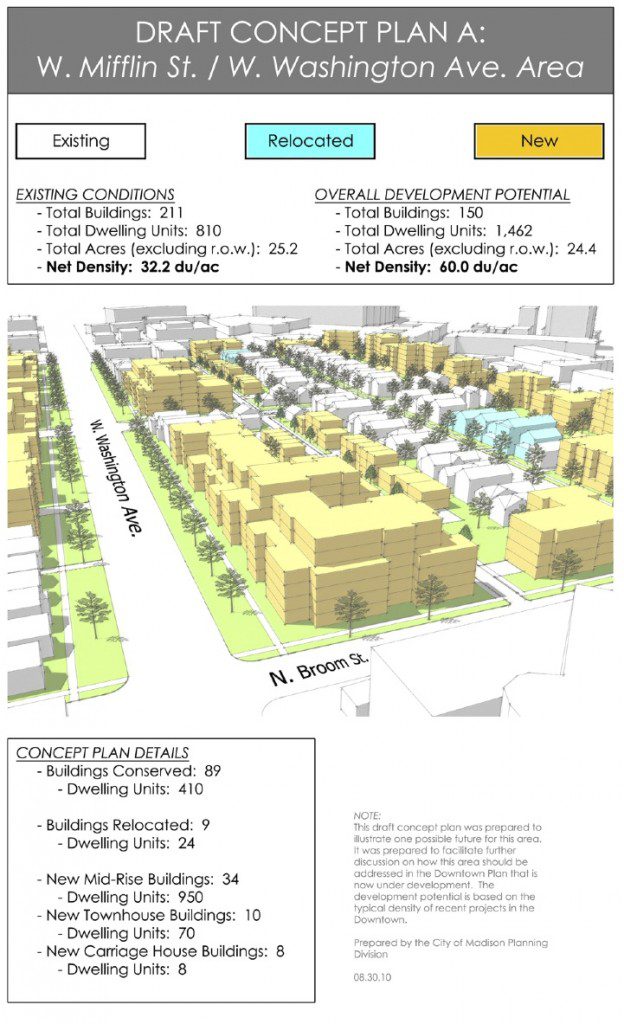
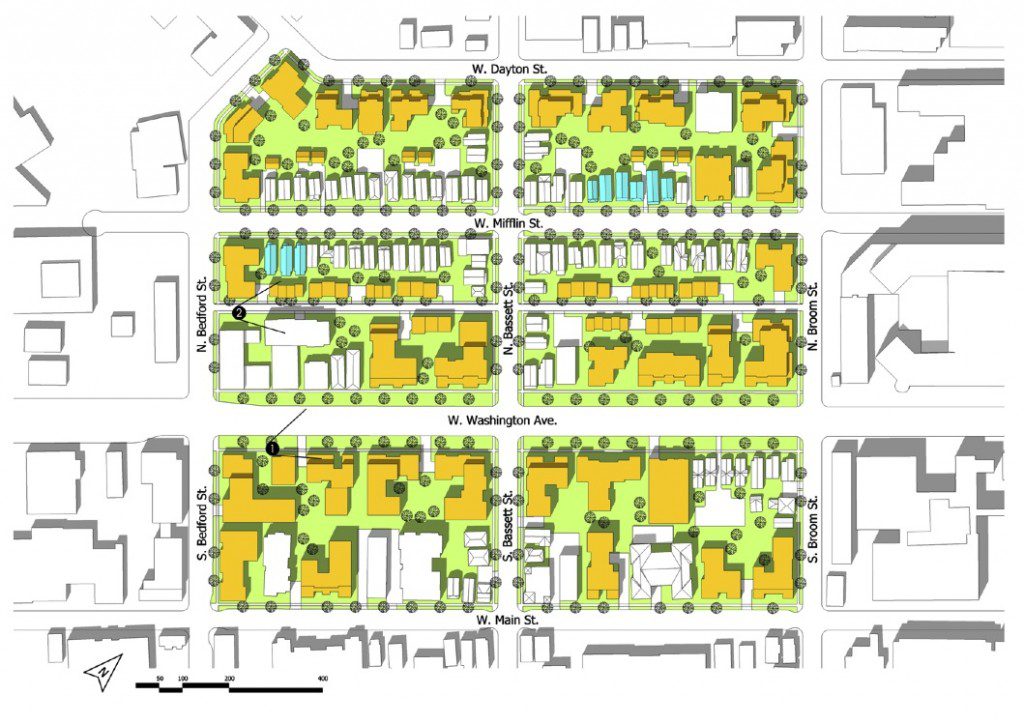
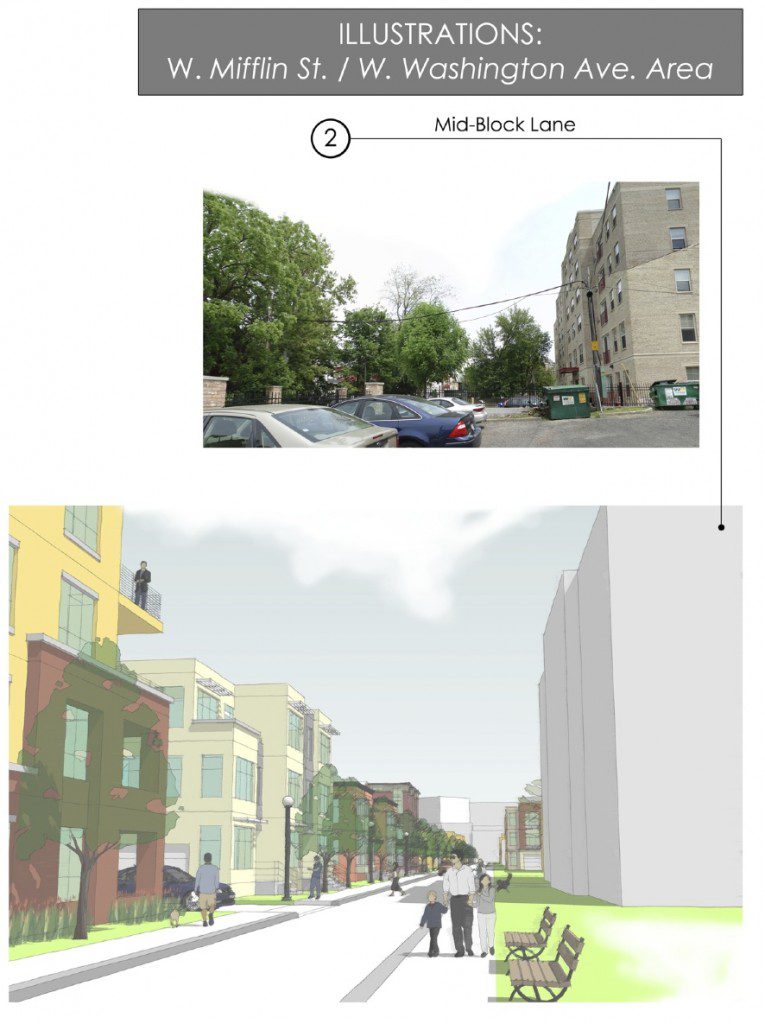
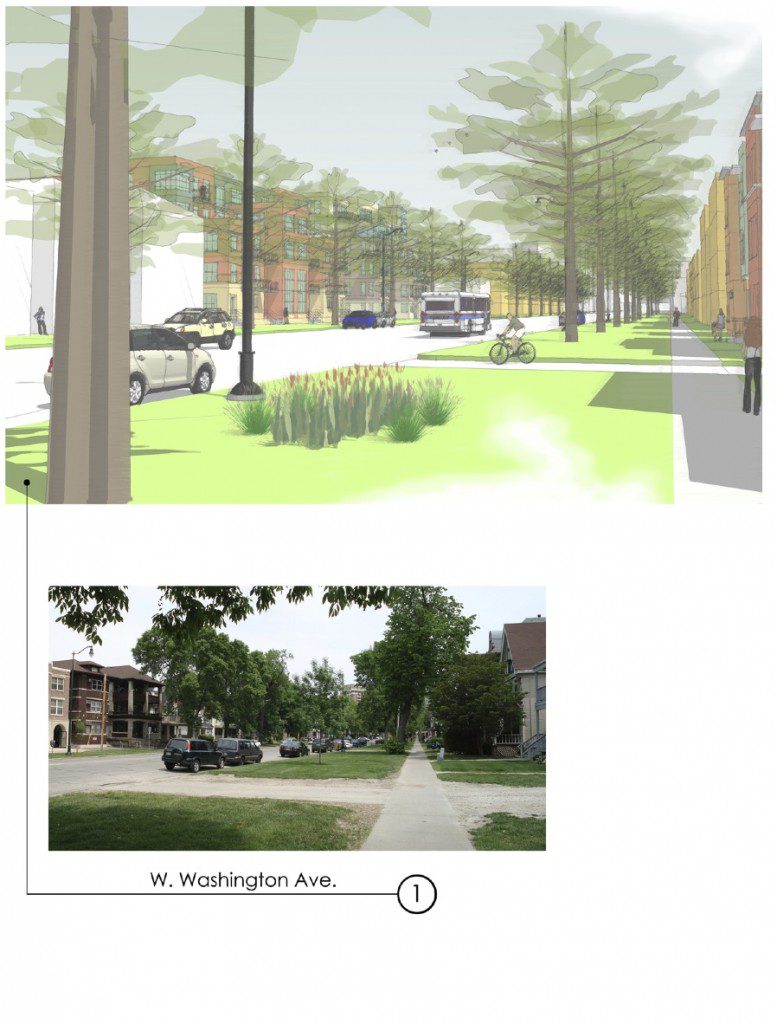
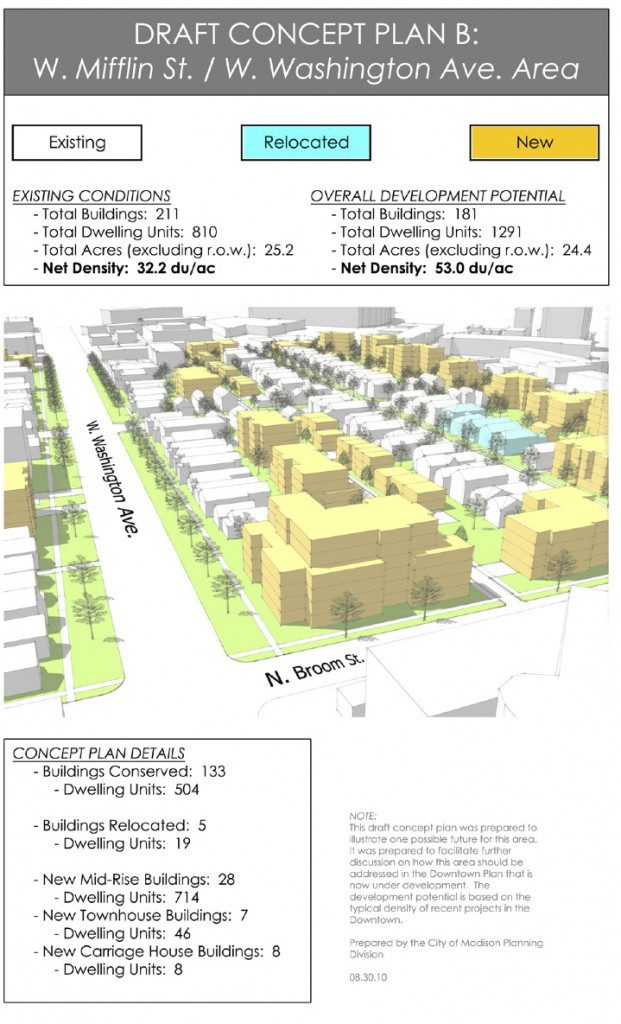
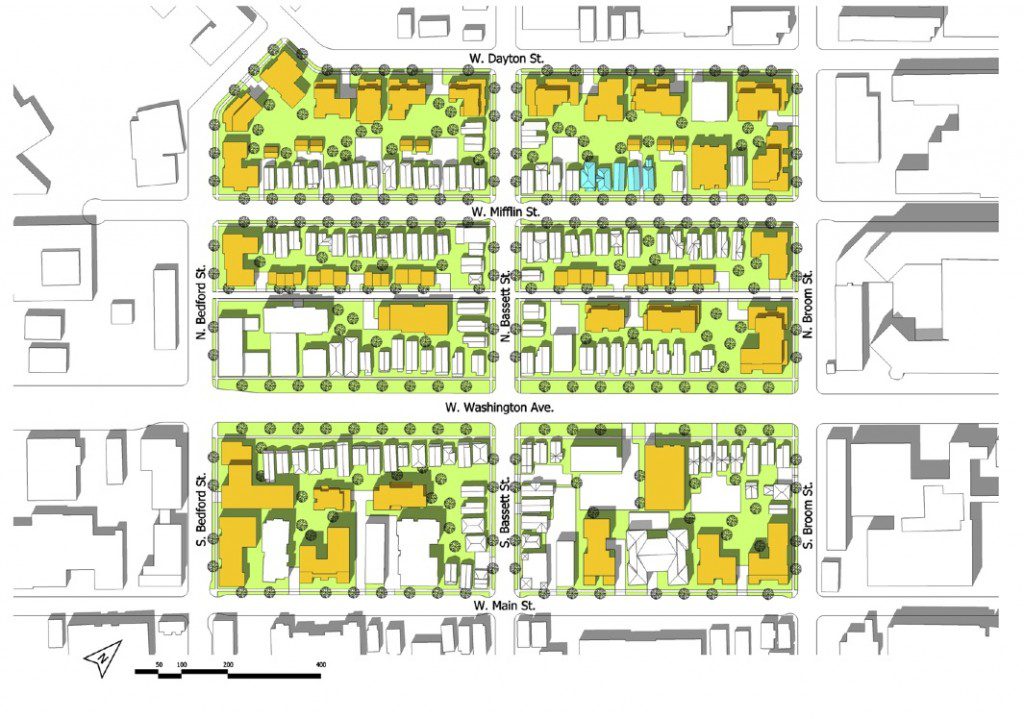





Great job, Erik. Thanks.
I vote for Option B.